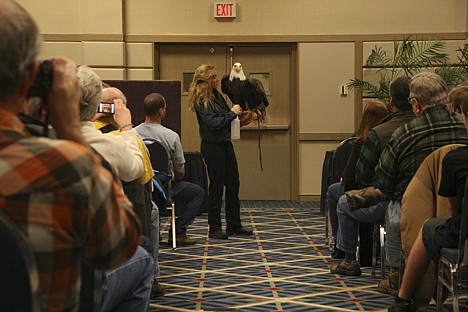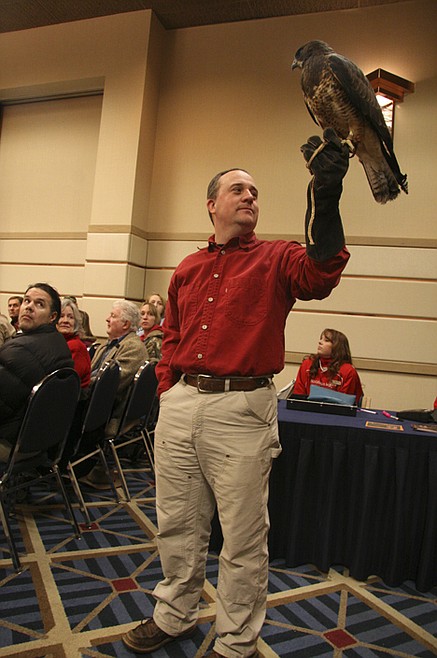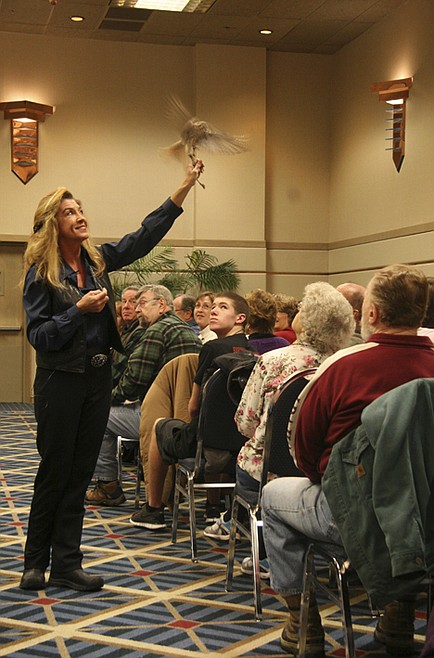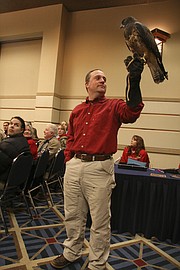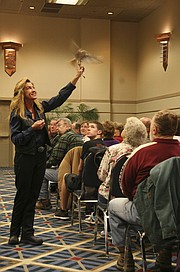Raptor roadshow
COEUR d'ALENE - Scout the great horned owl peered toward the rafters with big yellow eyes.
Dark brown and stately, he was staring at the decorative light fixtures that dangled overhead. Like golden tree limbs, they hung from the ceiling at The Coeur d'Alene Resort convention center, high above an audience of about 130 spectators.
To a bird like Scout, light fixtures can be very inviting.
"Wouldn't that make a nice perch?" joked raptor biologist Jane Fink.
The owl sat quietly on her gloved hand, watching as Fink lectured the crowd on Sunday. She revealed some little-known facts about Scout and his kind.
"Owls operate in a world of darkness," Fink explained. "They use their eyes, which are highly specialized, for nighttime vision."
Because of their unique wings, owls are completely silent when they fly, she added. By night they hunt mice and other small creatures; by day they sleep. Swallowing their prey whole, one family of owls will consume dozens - even hundreds - of mice in a 24-hour period.
"They control the rodent population in an environment," Fink said.
An expert on the eagles, hawks and owls of North Idaho, Fink works for Birds of Prey Northwest, a Coeur d'Alene-based organization that rescues, rehabilitates and studies injured raptors.
Staffed by volunteers and funded entirely by donations, Birds of Prey treats about 150 raptors every year. Sunday's Coeur d'Alene Resort lecture - followed by an optional eagle cruise out on the lake - was one of the organization's many educational and outreach events.
In addition to Scout, Fink displayed several other beautiful birds - a nimble American kestrel, a short-eared owl, a Swainson's hawk, a red-tailed hawk and a 20-year-old bald eagle named Liberty.
Raptors, Fink said, have three distinct characteristics: talons on their feet, a sharp, hooked beak, and remarkably powerful eyesight.
"Nobody has better developed vision on the planet than a raptor, particularly the bald eagle," Fink said.
She explained their anatomy, habitat and hunting methods, and pointed out that raptor females are always larger than males.
"(The lecture) was wonderful. It was really interesting and educational," said Sybil McCormack of Coeur d'Alene, who often looks for bald eagles near Mineral Ridge this time of year.
Those birds, the ones that congregate around Wolf Lodge Bay every December, are winter eagles, Fink said. They are not residents of North Idaho; they come swooping in from the north to feed on spawning kokanee salmon, then leave for warmer climes.
"They are a fish-eating bird, and almost always associated with water," Fink said of the bald eagle.
Wendell Wardell of Hayden learned a few things about raptors Sunday, he said.
"I think an ongoing education is important to keep (the birds) healthy," Wardell said. "It's very informative. (Fink) knows so much."
And it wasn't just adults who enjoyed the educational lecture - several kids turned out, too.
"Never been that close up to an eagle," said 13-year-old Bayley Brooks of Post Falls. "(I didn't know) that the eagles were nervous about nature (Fink said bald eagles are naturally quite skittish, with a very fast resting heart rate). I never would've thought that."
After seeing the raptors and hearing Fink's talk, 10-year-old Sarah Smith had become more environmentally-conscious.
"Makes me want to protect the environment more," she said. "Go green!"
If you find an injured raptor, don't try to hand-feed it, Fink said. Human interference will have a negative effect on the bird's ability to recover and return to the wild.
Cover the raptor's head with a shirt or jacket (watch out for the talons), place it in a box and call Birds of Prey Northwest - 245-1367 - or Idaho Fish and Game.

